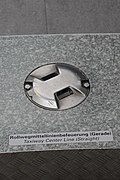





A taxiway is a path for aircraft at an airport connecting runways with aprons, hangars, terminals and other facilities. They mostly have a hard surface such as asphalt or concrete, although smaller general aviation airports sometimes use gravel or grass.
Contents
- High-speed exit
- Markings
- Signs
- Operational guidance signs
- Mandatory instruction signs
- Lights
- See also
- References
- External links
Most airports do not have a specific speed limit for taxiing (though some do). There is a general rule on safe speed based on obstacles. Operators and aircraft manufacturers might have limits. Typical taxi speeds are 20–30 kn (37–56 km/h; 23–35 mph). [1] [2]









